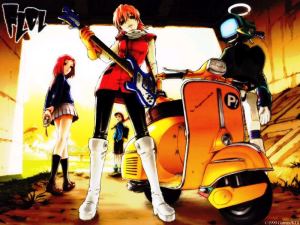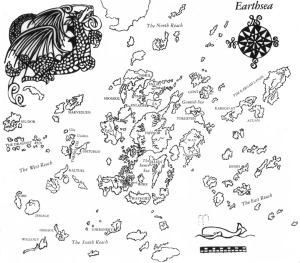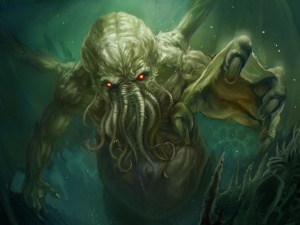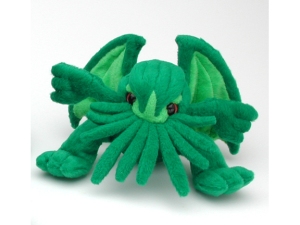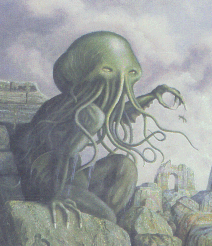
Moving on to the letter D, we come to another of my favorite things: Dragons. Powerful, ancient and universal, legends of dragons are found in essentially every culture and every time, up to and including the present. Dragons have been used, in different cultures, to represent each of the four classical elements (Air, Earth, Fire and Water) being the only mythic being I know of to have such a distinction. They’ve filled many character and archetype roles as well: Villain, hero, monster, god, adviser, schemer, embodiment of an abstract, good and evil, kind and cruel there is a dragon out there for every taste or narrative need.
Although many dragons, both in myth and especially in modern literature are intelligent beings capable of speech some are not and their are, to me oddly, some few people out there who are surprised when a dragon in a story speaks (I’ve actually had that happen to me with stories I’ve written.)
The biggest divide between dragons, in my view, is the geo-cultural one existing between dragons in the West and in the East. This divide creates various differences in the forms, personalities and morality of the dragons in question.
In the West, dragons frequently though not always have wings (Fafnir was a notable non-winged dragon or “wyrm” of Western origin although he 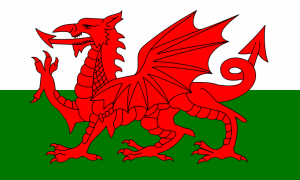 was, of course, born a dwarf), usually have four legs and a more or less lizard-like body and often breathe fire/smoke/poisonous fumes. Western dragons are often, but again not always, evil, frequently devouring humans-especially maidens-eating up livestock, burning down towns and generally carrying on. They are commonly greedy hoarders of wealth in the form of gold and jewels of all types. They tend to be associated with Fire or Earth on an elemental level, and in Christian contexts are often used as a symbol or metaphor, or seen as a potential form of, the Devil, Hell or the concept of “sin” itself. They were generally seen as beings of destruction and chaos, or else of cold cunning. However they are not always seen as bad…for instance, for many years “Y Ddraig Goch”, “The Red Dragon” has been the flag of Wales (particularly interesting to me, as my ancestry is partially Welsh-Williams is a Welsh name.) Notable dragons in classical Western tradition include Níðhöggr, Smaug the Dragon of Erebor, the dragon slain by Saint George and according to some, Grendel and/or his Mother.
was, of course, born a dwarf), usually have four legs and a more or less lizard-like body and often breathe fire/smoke/poisonous fumes. Western dragons are often, but again not always, evil, frequently devouring humans-especially maidens-eating up livestock, burning down towns and generally carrying on. They are commonly greedy hoarders of wealth in the form of gold and jewels of all types. They tend to be associated with Fire or Earth on an elemental level, and in Christian contexts are often used as a symbol or metaphor, or seen as a potential form of, the Devil, Hell or the concept of “sin” itself. They were generally seen as beings of destruction and chaos, or else of cold cunning. However they are not always seen as bad…for instance, for many years “Y Ddraig Goch”, “The Red Dragon” has been the flag of Wales (particularly interesting to me, as my ancestry is partially Welsh-Williams is a Welsh name.) Notable dragons in classical Western tradition include Níðhöggr, Smaug the Dragon of Erebor, the dragon slain by Saint George and according to some, Grendel and/or his Mother.
In the East, most dragons can fly, but they are rarely if ever depicted with wings and tend to be of a more serpentine shape. Their heads also 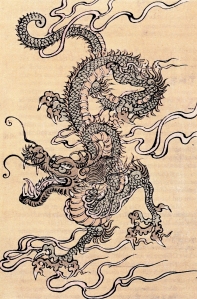 sometimes have a less reptilian form or aspect and often bear dear-like antlers rather than the horns often found on Western dragons. Eastern dragons are generally benevolent, sometimes even divine beings or the servants of gods and usually associated with the elements of Water and Air. Eastern dragons often had aspects of fertility (mostly via rain) protection and wisdom. In ancient China a dragon, usually with five claws, was the symbol of the Emperor. In Eastern myth dragons are usually part of the established order, rather than against it as in the West, although an aspect the two types sometimes share is that of guardians and also that of keepers of ancient knowledge or wisdom, however Western dragons often must be “paid off” to share their knowledge or power. Further, all Eastern dragons to my knowledge are conscious, speaking beings whereas some dragons in the Wester are depicted as non-sentient beasts. There are a few evil Eastern dragons such as the Japanese Orochi which is often depicted as a dragon, sometimes as merely a multi-headed serpent. Other notable Eastern dragons include Seiryu, the Blue Dragon of the East and one of the Four Sainted Beasts of East Asian folklore, and the Dragon King sea-god of China.
sometimes have a less reptilian form or aspect and often bear dear-like antlers rather than the horns often found on Western dragons. Eastern dragons are generally benevolent, sometimes even divine beings or the servants of gods and usually associated with the elements of Water and Air. Eastern dragons often had aspects of fertility (mostly via rain) protection and wisdom. In ancient China a dragon, usually with five claws, was the symbol of the Emperor. In Eastern myth dragons are usually part of the established order, rather than against it as in the West, although an aspect the two types sometimes share is that of guardians and also that of keepers of ancient knowledge or wisdom, however Western dragons often must be “paid off” to share their knowledge or power. Further, all Eastern dragons to my knowledge are conscious, speaking beings whereas some dragons in the Wester are depicted as non-sentient beasts. There are a few evil Eastern dragons such as the Japanese Orochi which is often depicted as a dragon, sometimes as merely a multi-headed serpent. Other notable Eastern dragons include Seiryu, the Blue Dragon of the East and one of the Four Sainted Beasts of East Asian folklore, and the Dragon King sea-god of China.
Dragons are common elements of modern fantasy literature, often fusing East and West; many literary dragons, especially in the last couple of decades, are like Western dragons in shape but there have come to be many such that resemble Eastern dragons more closely in temperament. Stories such as the Inheritance Cycle, and the Pern books feature benevolent dragons as central characters and heroes. Others take a middle ground, such as in the world of Earthsea, where dragons and humans are related but took different paths, some dragons being malicious towards mankind, others simply wanting to be apart. In Dungeons and Dragons there are more varieties of dragons than colors in the rainbow, ranging from good to “neutral” to evil and back. To many lovers of fantasy in modern times-and indeed I feel even throughout history-dragons have been, are and will continue to be symbols of all that is magical, mysterious and fantastic. Indeed many modern dragons of literature and games are just that, eidolons of magic or of all things primal.
 I’ve always had a fondness for dragons, personally, that became much stronger when I was a kid and read the foreword of an anthology called “Dragon Fantastic”, that spoke extensively of Dragons as the archetypal creatures of magic and fantasy, embodiments of myth and wonder. That above all is what they mean to me. I don’t have as many dragons in my fiction as I would have expected, but they do pop up and are definitely a feature in the Universe of the Nine Roads. Many dragons are Node Guardians, protecting and regulating places in the world where the power of a particularly Road is especially strong and concentrated.
I’ve always had a fondness for dragons, personally, that became much stronger when I was a kid and read the foreword of an anthology called “Dragon Fantastic”, that spoke extensively of Dragons as the archetypal creatures of magic and fantasy, embodiments of myth and wonder. That above all is what they mean to me. I don’t have as many dragons in my fiction as I would have expected, but they do pop up and are definitely a feature in the Universe of the Nine Roads. Many dragons are Node Guardians, protecting and regulating places in the world where the power of a particularly Road is especially strong and concentrated.
Copyright Disclaimer: The images in this blog post do not belong to me. I found them via Google search and they are the property of their respective creators/owners, whoever they may be. If you are the creator/owner of one of these images and you wish your work removed please let me know and I will comply immediately.
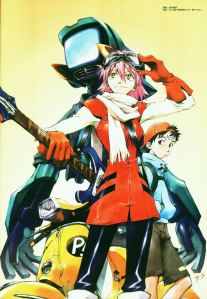 But at the root of the story are themes of coming of age emotionally and coming to terms with ones feelings. There is a degree of sexual awakening innuendo as well-Mamimi and Haruko both flirt shamelessly with Naota and one of his classmates clearly has a crush on him…plus which, several of the protrusions that grow from his head have a vaguely phallic appearance and implications, but it’s all handled in a very humorous way. There are also themes like juvenile delinquency, the breakup of the family unit and various concepts of self-determination explored.
But at the root of the story are themes of coming of age emotionally and coming to terms with ones feelings. There is a degree of sexual awakening innuendo as well-Mamimi and Haruko both flirt shamelessly with Naota and one of his classmates clearly has a crush on him…plus which, several of the protrusions that grow from his head have a vaguely phallic appearance and implications, but it’s all handled in a very humorous way. There are also themes like juvenile delinquency, the breakup of the family unit and various concepts of self-determination explored.